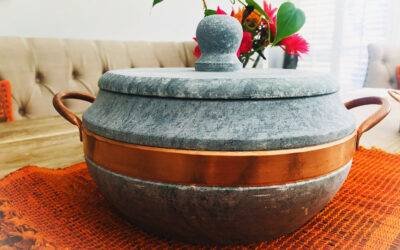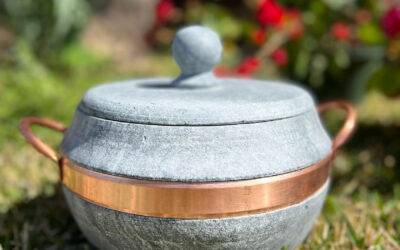
Welcome to the world of soapstone cookware—a choice that combines aesthetics with functionality in your cooking. Renowned for its durability and unique ability to retain heat, a soapstone pot is more than just a piece of cookware in your kitchen. It is a piece of culinary heritage that brings rustic charm and unparalleled performance to your cooking efforts. Whether you are simmering a stew or slow cooking a hearty soup, the soapstone pot stands out for its naturally non-stick properties. But, like any other cookware, it demands proper care to maintain its functionality over time.
In this post, we will talk through the required steps to care for your newly purchased soapstone pot, ensuring it serves you well for years to come. From initial preparation to regular maintenance, let us dive into the best practices to cherish and preserve your soapstone cookware.
Initial Preparation
Once Your Soapstone Cookware Arrives to your home, Seasoning is crucial in preparing your cookware for its first use, enhancing its natural non-stick properties, and its longevity. To season your pot please read our post on " “5 Essential Steps to Season and Preserve Your Brazilian Soapstone Cookware for a lifetime“
Here is how to take care for your soapstone cookware
Adapting to Your Home’s Environment:
Unpack your soapstone pot andlet it sit on your countertop for about 45 to 60 mins. This allows the soapstone pot to get used to your home’s temperature and humidity levels.
The Boiling Water Method:
Bring a pan of water to roaring boil. Pour the hot water into your soapstone pot to the metal rim and cover it with the lid provided with the pot. Leave it undisturbed until both the water and the pot have completely cooled down. This process helps the cookware to adapt to your home’s conditions and opens the stone’s pores.
Oil Application:
After the pot has cooled drain the water and gently wipe to dry it with a soft cloth. Apply a few drops of cooking oil, wiping the interior and exterior surfaces to coat them lightly. This step is crucial for creating a protective layer to contribute to the cookware's non-stick surface and prevent it from drying out.
By following these simple steps, you are not just preparing your soapstone pot for its cooking, embarking on its journey to create meals that are not only nutritious but delicious too, with a cookware that only gets better with its everyday use.
Cleaning and Maintenance:
Ensuring your soapstone cookware remains a dependable companion in your culinary adventures involves simple yet specific care. The soapstone’s natural properties make it remarkably easy to maintain, provided you adhere to some basic guidelines that protect its integrity and enhance its cooking performance.
After Every Use:
Cooling Down Always allow your soapstone pot to return to room temperature before attempting to clean it. This crucial step prevents thermal shock, which could lead to cracking or damage over time.
Rinsing and Washing:
The best way to clean your soapstone cookware is by rinsing it with normal water using a soft sponge. For a deeper cleanliness, gently rubbing with coffee grounds is sufficient, but remember, the key to preserve the stone’s natural finish is to avoid using any chemical dish liquid.
Re-oiling Post-Wash: After each wash, it is essential to reapply a light coat of cooking oil to the pot’s interior and exterior. This step not only restores the cookware’s non-stick surface but also prevents the stone from drying out and maintains its lustrous appearance.
Special Care for Copper Handles:
Your soapstone pot or soapstone pan or soapstone grill may feature elegant copper handles, which naturally patina over time due to air exposure. To revive their shine:
- Tamarind Paste Method: Apply wet tamarind paste, let it sit for 15 minutes, then gently rub and rinse.
- Vinegar and Salt Paste: Mix salt with white vinegar, add wheat flour to create a paste, apply it on the copper, and after 15 to 30 minutes, rinse off.
These methods are not only effective but also avoid harsh chemicals, aligning with the natural care methods of soapstone cookware combining timeless elegance with unparalleled functionality.
Enjoying Your New Soapstone Cookware Pot in the Kitchen
Embracing the versatility and durability of your soapstone cookware is the key to a rich culinary experience. As you welcome this new addition to your kitchen, here are some guidelines to ensure your soapstone cookware not only performs exceptionally but also stands the test of time, becoming a legacy in your culinary collection.
Seasoned and Ready: Your soapstone pot arrives seasoned and has been gradually heated to 220 degrees Fahrenheit, ensuring it is ready for use right outside of the box. This meticulous preparation process guarantees that your cookware is free of imperfections, offering a flawless cooking surface for a wide array of dishes.
Gentle Heat Increase: Begin your cooking adventures on a low flame, gradually increasing to a medium setting. This approach is crucial as hot temperatures are unnecessary and can harm your pot over time. Soapstone’s excellent heat retention means your food will cook beautifully without the need for high heat.
Ideal for Liquid-Based Recipes: For the first few uses, choose recipes that start with a liquid base, like soups or stews. This method allows your pot to adjust to regular use gently and is perfect for the slow cooking process that soapstone excels at.
Avoid Dry Heat: Never leave your soapstone pot empty over an active burner, even for a brief period. If preheating is necessary, start with a small amount of oil on the lowest heat, gradually adding ingredients as the pot
warms up.
Even Heat Distribution: To ensure your soapstone cookware heats evenly and to protect it from thermal stress, use a heat diffuser. A diffuser slightly larger than the pot’s base will provide optimal performance, easily found on online marketplaces.
Post-Cooking Care: After cooking, let the pot cool completely before cleaning. This step is vital for the cookware’s longevity. Clean gently with a soft cloth under lukewarm water, avoiding dish liquids. Once dry, a light application of cooking oil will preserve the non-stick surface and prevent drying or cracking.
Utensil Selection: Choose LFGB silicone or wooden utensils when interacting with your soapstone pot. This careful selection maintains the cookware’s condition, ensuring it remains scratch-free and beautiful.
Adhering to these simple yet effective guidelines will ensure your soapstone pot not only enhances the flavors of your meals but also becomes a cherished tool in your kitchen, forging memories for generations.
As we wrap up our guide on caring for your newly purchased soapstone cookware, the beauty and functionality of this unique material make it a valuable addition to any kitchen. By following the simple steps for initial preparation, regular cleaning, and careful maintenance, you can ensure that your soapstone pot will serve you well for many years to come, enhancing every meal with its natural non-stick surface and excellent heat distribution.
Soapstone pots are more than just a piece of cookware used for cooking; they are a piece of culinary heritage that brings a touch of elegance and tradition to your modern kitchen. With each use, it tells a story of meals lovingly prepared and shared, becoming an integral part of your family’s
culinary adventures.
We hope this post has provided you with helpful insights into caring for your soapstone pots and pans.
Do not forget to explore our other related posts for additional insights into maintaining and enjoying your soapstone cookware to its fullest. Your journey with soapstone is just beginning, and we are here to ensure it is a delightful one.
Thank you for choosing to enhance your culinary experiences with soapstone cookware. Here are too many memorable meals and moments in the kitchen!








0 Comments